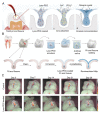Engineered Biomaterials Trigger Remineralization and Antimicrobial Effects for Dental Caries Restoration
- PMID: 37687202
- PMCID: PMC10489995
- DOI: 10.3390/molecules28176373
Engineered Biomaterials Trigger Remineralization and Antimicrobial Effects for Dental Caries Restoration
Abstract
Dental caries is the most prevalent chronic disease globally, significantly impacting individuals' quality of life. A key reason behind the failure of implanted restorations is their biological inactivity, meaning they are unable to form crosslinks with the surrounding tooth structures, thus making patients susceptible to implant loss and recurrent tooth decay. For the treatment of caries, antibacterial medicine and remineralization are effective means of treating the recurrence of caries. Owing to the rapid progression in the biomaterials field, several biomaterials have been reported to display antimicrobial properties and aid in dentin remineralization. Bioactive materials hold considerable potential in diminishing biofilm accumulation, inhibiting the process of demineralization, enabling dentin remineralization, and combating bacteria related to caries. Bioactive materials, such as fluoride, amorphous calcium phosphate, bioactive glass, collagen, and resin-based materials, have demonstrated their effectiveness in promoting dentin remineralization and exerting antibacterial effects on dental caries. However, the concentration of fluoride needs to be strictly controlled. Although amorphous calcium phosphate can provide the necessary calcium and phosphorus ions for remineralization, it falls short in delivering the mechanical strength required for oral mastication. Resin-based materials also offer different advantages due to the complexity of their design. In this review, we delve into the application of advanced bioactive materials for enhancing dentin remineralization and antibacterial properties. We eagerly anticipate future developments in bioactive materials for the treatment of dental caries.
Keywords: antibacterial; biomaterials; dental caries; dentin remineralization.
Conflict of interest statement
The authors declare no conflict of interest.
Figures




References
-
- Xu Q.A., Fan M.W. Research progress in ecological prevention of dental caries. Chin. J. Stomatol. 2022;57:297–301. - PubMed
-
- Gao Y.B., Hu T., Zhou X.D., Shao R., Cheng R., Wang G.S., Yang Y.M., Li X., Yuan B., Xu T., et al. Dental Caries in Chinese Elderly People: Findings from the 4th National Oral Health Survey. Chin. J. Dent. Res. Off. J. Sci. Sect. Chin. Stomatol. Assoc. (CSA) 2018;21:213–220. - PubMed
Publication types
MeSH terms
Substances
Grants and funding
LinkOut - more resources
Full Text Sources
Medical

